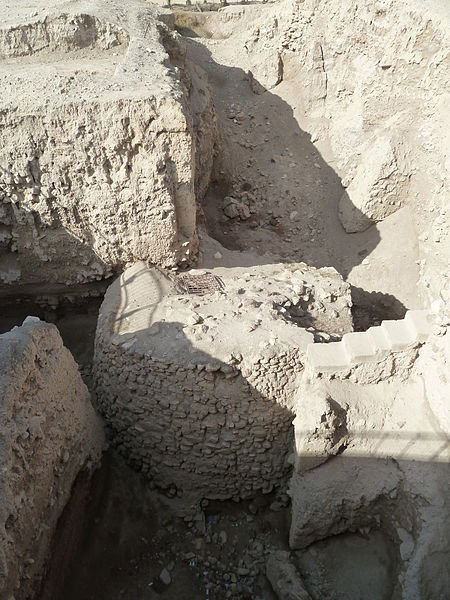Deror_Avi, Wikimedia Commons. December 5, 2012.
The Neolithic Tower, Tell Es-Sultan, Jericho
By Julia Olson
Assistant Editor
In Joshua 6, the attack on Jericho is laid out by God and then carried out by the Israelites. From what we know about them, the Israelites often struggle with accurately following directions (how many times do we hit the rock for water? Whose foreign gods shouldn’t we worship? What about these foreign women, can’t we take them as wives?). But this is a new group, fresh from crossing the Jordan, and at least at this time, they can take instructions. God details a plan for them, giving instructions to march around the city once a day for six days. On the seventh day, they are to march around the city seven times and the priests are to blow their horns. When the horns are blown, the people are to shout and then the walls of Jericho will fall down. And guess what? They do it! There’s marching, shouting, horns, and, just as God said, the walls come a-tumblin’ down. The Israelites will go on to win some and lose some in the conquest story and, as the book of Judges will show us, their success is certainly impermanent. But for right now, they have Jericho!
Fantastic. But what about the walls of Jericho today?
The remains of the ancient city of Jericho are in the West Bank. The site is also known as Tell es-Sultan, and it is one of the oldest and longest inhabited cities of the ancient world. Jericho is a gold mine for historians (and not just Biblical historians!). The first people to inhabit the site were there before the invention of pottery making. In ancient Middle Eastern archaeological terms, we refer to these periods as Pre Pottery Neolithic A and B (PPNA,B). Of course, the “Neolithic” part of that title ensures us that, while they may not have had clay pottery, they certainly had stone tools and vessels. The first folks to live there were probably there around 9,000 BCE. That’s about 11,000 years ago!
One of the things for which Jericho might be most famous is….ready for it? WALLS. That’s right, the ancient city of Jericho is known for having some of the oldest defensive walls in the known world. They were likely built around 8,000 BCE (10,000 years ago, give or take). No wonder the biblical authors reference them — they were probably extremely well known by the point of its authorship. Fortifications such as thick defensive walls were not common during the time when those at Jericho were built, which makes these all the more fascinating. Walls can tell us a lot of things in the ancient world. For instance, they can tell us that the folks living inside them felt they had something to protect. Conversely, they tell us that the folks living outside of them may have sought to obtain that something and thus needed to be kept out. What’s more, large walls like those at Jericho tell us that there was community organization. Building monumental architecture is not a one person job. Walls that are 13 feet high and six feet thick require planning, design, and the organization of labor. We do not have clear numbers as to the amount of residents of Jericho during the Pre Pottery Neolithic era, but certainly there were enough people to engage in the building of these very strong walls.
Among the famous Jericho walls is what is known as the Tower of Jericho. This circular structure was built at the same time as the walls, however its function is far less clear. Scholars and archaeologists still cannot agree. Is it part of the fortification? If so, it is a curious part, as it is built on the inside of the walls, rather than on the outside. We would expect a watchtower to be outside the walls, so the placement of the Jericho Tower inside raises questions about its use as lookout. It is not a tomb, as no human remains have been found in or near the tower. Dr. Ran Barkai of Tel Aviv University and Roy Liran of the Israel Antiquities Authority have suggested that the tower serves a celestial purpose, making it a sort of mega-sized ritual object. Needless to say, even after 10,000 years, the walls of Jericho still contain multitudes of mysteries for modern scholars. But what we can know for sure is that these monumental walls had an enduring impact on the authors of the Hebrew Bible. The walls of Jericho were such a formidable part of the landscape that the authors adapted them as a symbol of the pagan worship in the land of Canaan that could only be defeated with the help of God (and a couple of shofars.) The walls of Jericho not only leave an indelible mark in the Hebrew Bible, but they continue to provide a lasting reminder of human ingenuity across space and time.
Resources Cited and Further Reading
Barkai, Ran & Liran, Roy. (2008). “Midsummer Sunset at Neolithic Jericho.” Time and Mind. 1. 273-273.
Stiebing Jr. & Helft, Ancient Near Eastern History and Culture, Routledge, 2017





